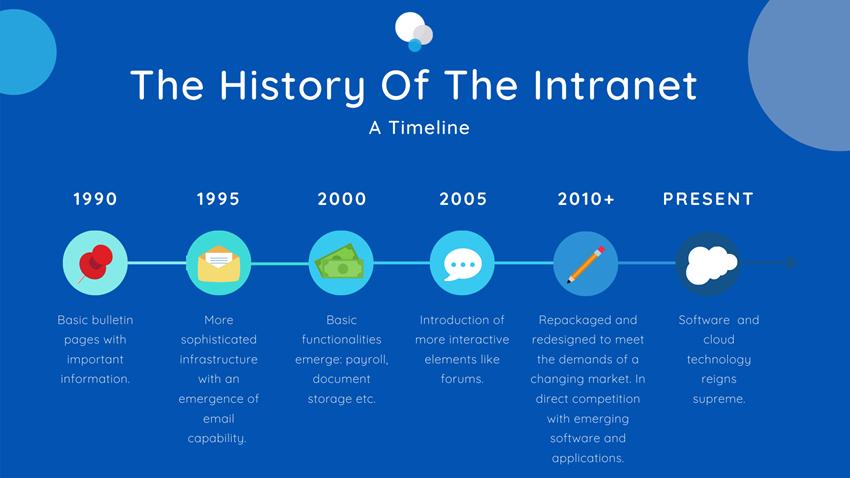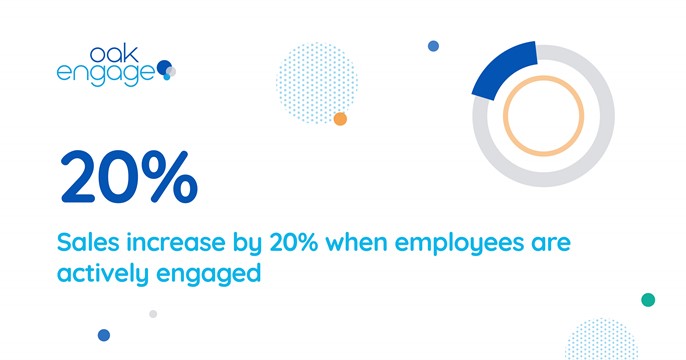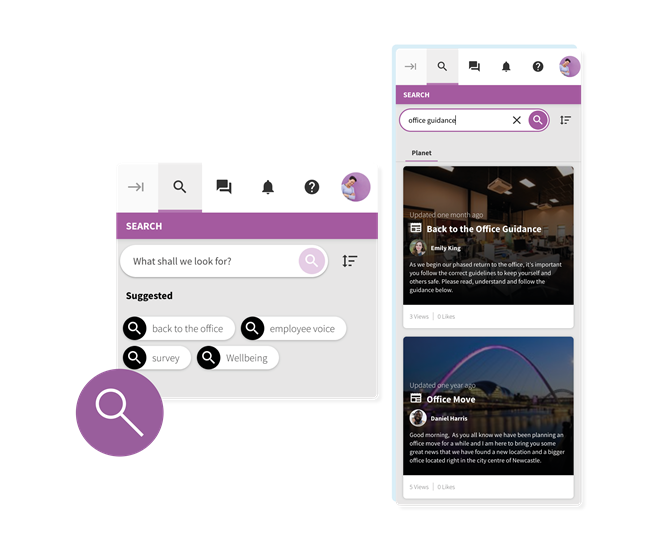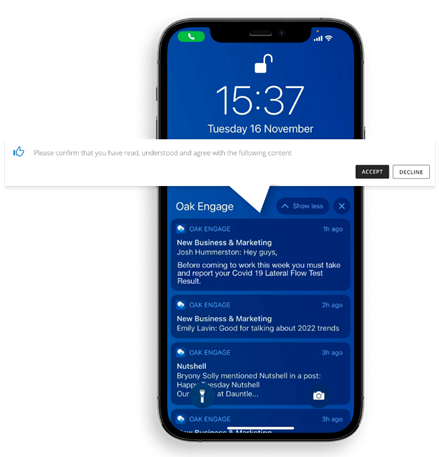As companies introduce new technology into the workplace to engage and communicate with their workforce, are intranets becoming outdated? In this guide, you’ll learn:
- What Is An Intranet?
- A Brief History of Intranets
- What is your Internal Comms Score?
- What is the purpose of an intranet?
- What is the difference between an intranet and an internet?
- What is the difference between an intranet and an extranet?
- On-Premise Vs Cloud-Based Intranets
- Intranets vs Social Intranets
- Intranets vs Digital Workplace
- Traditional vs Modern Intranets
- Advantages of an Intranet
- Disadvantages of an Intranet
- What should an Intranet include?
- Examples of an Intranet
What Is An Intranet? (Intranet Definition)
Intranet Definition: An intranet is a private enterprise network designed to empower employees to communicate, collaborate and perform to the best of their ability. It serves a broad range of purposes and uses, but generally speaking, an intranet is to engage and support employees.
Employees can typically use this internal network to:
- Connect to one another
- Collaborate on projects
- Send messages
- Share documents
- Access policies
- Request time off and more
A Brief History of Intranets
Intranets have become increasingly important and valuable to companies since making an appearance into the digital scene in the 1990s. Traditional intranets have shifted into something new, often referred to as a digital workplace.
A traditional intranet used to be nothing more and nothing less than an internal website. It was accessible to employees from a certain company within that company's walls.
The purpose of these early intranets was only for content and communication, sent out by the internal comms department or HR.
Slowly but surely integrations were added to traditional intranets and collaboration started playing a bigger role. This was the first step towards the ‘digital workplace’.
Now, companies are relying more and more on their internal networks for content, communication, activity and collaboration for their employees.

What is Your Internal Comms Score?
A modern intranet can revolutionise your internal comms, but you have to use the right software in the right way. Find out your Internal Comms Score here:
What Is the Purpose of an Intranet?
Now you know what an intranet is, let’s look at its main purpose of one. Put simply, a corporate intranet is aimed to connect employees to perform different tasks. This, of course, is a very wide definition of an intranet’s purpose, so let’s dive deeper.
To Improve Employee Engagement
A company intranet can be used for things like contests, events, polls, and photo galleries. In fact, this can be a great appeal to get employees to come back to their intranet every day. You can create a dedicated space for these activities - like a social timeline or even a dedicated page. Gallup found that sales increase by 20% when employees are actively engaged. At the same time, profitability increased by 21%.

Developing Team Collaboration
With the rise of remote work and virtual, dispersed teams, being able to leverage your intranet as a team collaboration tool is critical. Managing team projects using email and shared drives can be complicated and unnecessarily time-consuming.
Instead, you can create a document management system on your company intranet where you can share files, important dates, and progress updates. It’s all contained, organised, and accessed by team members - wherever they are.
To Enhance Internal Support
Intranets allow large organisations to easily manage their queries from employees. Companies without the use of intranets have technical and coordination difficulties on a daily basis, which can lead to a constant flow of negative feedback from workforces. Intranets are one of the best tools to manage and gather feedback and requests in an organised, secure way.
To Improve Internal Communications
Since an intranet is an organisation’s digital hub, HR management can broadcast important information throughout the organisation – changes at the corporate level, important events, recognition of performers, and announcements related to new policies.
To Improve Productivity
It’s essential that you’re providing your employees with the right tools in your company intranet to increase overall productivity. You don't want your workforce to be endlessly searching for the right tools or features which will hinder their productivity and cause them to lose focus.
What Is the Difference Between an Intranet and an Internet?
An intranet is a restricted and internal network that enables people to store, share and organise information within the organisation.
The internet is a globally-connected network that enables people to share information and communicate with each other.
Although they may easily get mixed up, there are key differences between the two, one of the most important being that an intranet is a platform that can be bought to help improve various aspects of your company. The internet on the other hand, is the underlying technology that enables its connectivity.
What Is the Difference Between an Intranet and an Extranet?
An extranet is a web portal that is accessible by an organisation and its external vendors, partners, customers, or any other users that require access to restricted information.
With an extranet, the host organisation manages the site administration and content, and provides controlled access to internal and external members.
On-Premise vs Cloud-Based Intranets
There are two kinds of intranet platforms available to organisations, each requiring different types of hardware.
On-Premise - The intranet is completely hosted on-site of a business, on a server managed, updated and backed-up by a dedicated IT team. However, mainly large enterprises have the capability to dedicate resources to the complexity often on-premise intranet maintenance.
Cloud-based - Most modern intranets are cloud-based, meaning it’s instantly made available online, instead of having to build and maintain on-premise infrastructure.
Cloud-based intranet software comes from a dedicated intranet provider, such as Oak. There are less resources required as only an internet connection and computers are needed.
Benefits of a cloud-based intranet include:
- Easier customisation
- Optimisation
- Responsiveness
- Minimises up-front IT costs
- Less maintenance
- Easier management
A small intranet team with 'Content Captains' are responsible for the management and creation of content to keep the intranet fresh and updated.
Intranets vs Social Intranets
Traditional intranets often don’t allow the level of communication employees need to get the most out of their digital workplace. Social intranets, however, are typically more user-friendly, allowing anyone with permission to upload posts to their social timeline, comment, and ask or answer questions.
A social intranet performs the same functions as social media applications but usually in the workplace. It’s an internal communication and collaboration platform which helps employees connect and build relationships. A social intranet encourages information sharing, interactions between colleagues and working together on common goals.
Social intranets are much more intuitive, familiar, cloud-based, and flexible.
Some features you’re likely familiar with from social media platforms that you can now find on social intranets include:
- Interactive profiles with an activity stream
- Blogs and content areas, forums, Q&A, discussion areas
- Team and project hubs for collaboration
- Social hubs for like-minded colleagues to meet
- Instant messaging and other social interaction features
Intranets vs Digital Workplace
To put it simply, an intranet can be a part of your digital workplace, but your digital workplace isn’t a part of your intranet. A digital workplace is the wider umbrella that encompasses all the digital tools your enterprise uses. It began life as a sort of catch-all term for email, word processors, and fledgling internet applications, but has since evolved into a key facet of modern business.
Depending on the business case and your enterprise’s unique requirements, different solutions may apply. If you need to tie together all your digital tools under one roof, you need a digital workplace platform. If you need an outward face of your broader digital workplace, a kind of digital entry-point for employees, you need an intranet solution.
Traditional vs Modern Intranets
The traditional model of intranets typically had upper management creating content and comms to go out to the organisation’s employees, with little to no interaction back on the part of the employees. Traditional Intranets were commonly confined to the organisations’ local network, which meant that any employee trying to access the intranet remotely would have to use a VPN (virtual private network).
Intranet solutions today have shifted away from the one-way communication model, and more towards a social hybrid by enabling users to create and share content. This allows for more employee engagement and better collaboration. The modern intranet allows organisations to choose between a cloud intranet option or a local install (on-premise) intranet and enable remote access to the site.
Recommended Reading 📖: Are Intranets Still Relevant?
Advantages of an Intranet
Modern intranets are flexible, simple and employee-friendly, and easily adapt to suit an organisation’s goals. If your team needs a creative outlet, a collaboration hub, or a digital workplace, that’s when an intranet comes into effect to support those needs.
Core advantages of a modern intranet include:
Document Management
Key information important to your business, including policies, procedures, content creation can all be secured in a document management system. Content management brings all content into an easily accessible and searchable location.
Improved Business Collaboration
Intranets assist in day-to-day business activities, and with the inclusion of social technology, meet the collaboration needs of employees through profiles, live messaging, forums and status updates. Employees can contact the people they need to effectively work on projects and finish tasks.

Successful Internal Communications Strategy
As a central location for the content, documents and information, dedicated homepages on your intranet keep your employees updated on the small and large happenings of a company. Communications could include blog posts, articles, newsletters, policies, and company training documents.
Smoother Organisation Workflow
Make better decisions faster as an intranet connects teams to the information and tools they need for an improved workflow experience. Book holidays and absences, file expenses, and view usage analytics.
Consistent Internal Branding
A great intranet provides the flexibility and ease to customise the appearance and reflect the organisation. When an employee logs on, they immediately recognise the brand identity of the company. This acts as a constant reminder of the manifesto, quality and ethos they should work with.
Integration and Connectivity
Communication software has seen a surge of innovative tech. For nearly every need an employee faces at work, an app or tool has been designed for it. A modern intranet brings them all together in one central location
Mobile Access
There’s a growing demand for a work-life balance, remote working and flexible hours that is encouraging companies to look for more secure options to connect. Having mobile access to your company intranet makes it easier for your workforce to connect, wherever they are.
Disadvantages of an Intranet
With a traditional intranet, there are certain limitations that will disengage employees. The top 3 disadvantages include:
- Poor search functionality
- Outdated document management capabilities
- Frustrating or non-existent communication tools
With Oak Engage, this is not the case. Our focus is on providing modern and social intranets, which are more user-friendly and focus on improving communication, collaboration and consistency of content within the workplace.
Our ‘Search Functionality’ enables users to locate all content, past or present, quickly and there's no more wasting valuable time searching for important documents. Oak’s federated search is designed to find whatever you need instantly, helping employees save time and be more productive.

Oak solution also allows companies to store their important documents securely, in one single place, meaning there's no more worrying about outdated document management systems. Oak eases accessibility, improves security and frees workspaces within your organisation.
Communication tools are so important to connect your employees within your intranet. Therefore we provide a mobile app filled with opportunities for social and community engagement and collaboration. Perfect for department communication, remote workers and general social interaction between employees.
What Should an Intranet Include?
When looking for an intranet software there are many things to consider before choosing a platform. Your intranet should speak for your company as a whole, which means it’s important to be picky and not go with the first option that presents itself.
We’ve put together a list of the 5 most important intranet features you should have or be looking for in your intranet search.
Recommended Reading: 31 Intranet Features Your Company Needs (Ultimate Checklist)
Mobile Functionality
These days, many people do just as much work on their smartphones and tablets as they do on their laptops. Therefore, the ability to access your company intranet from a mobile device is one of the most essential intranet features. Building a mobile intranet app is not something that all software companies are willing to do, which is why it’s important to be cautious about which intranet software you choose to adopt.
The Oak Engage app employees an enjoyable experience and can access their company intranet wherever they are. This is ideal for organisations with deskless or remote workers - it gives companies the power to access their intranet solution at any time, from anywhere.

News and Social Feeds
One of the most important ways to keep everyone in your digital workplace on the same page is to ensure that they all are informed about the latest company news and updates.
Oak Engage news and social feeds are designed to unite teams and promote solidarity with your company's own social feed. With the social intranet software, employees have a space to create bonds and relationships with other colleagues, increasing productivity, collaboration and connectivity.
Social timelines also allow employees to catch up on the latest news and announcements or interact with colleagues through customisable content feeds. Employees can comment, like, upload media and more. Timeline helps workforces to stay connected, engaged and aligned.

Content Management
Your intranet content can mean the difference between your intranet becoming a thriving hub of activity or a ghost town. It’s so important to have a system where your employees can complete tasks easily and seamlessly.
Oak’s content management system helps employees easily access content to complete tasks quickly anywhere, anytime and stay connected with other employees and the organisation; streamlining internal communication, improving productivity and cultivating a positive corporate culture.
Employee Recognition Software
Employee recognition in the workplace has to be a vital part of a company's culture. In today’s work environment, the companies with the most satisfied and engaged employees are the ones that have the best training programmes and well-skilled staff.
Therefore, employee recognition software in an intranet is such an important tool to boost morale. Oak Engage's employee recognition and awards feature lets employees know that management cares by celebrating milestones like birthdays and work anniversaries. This feature has an inbuilt timeline, meaning employees can comment on achievements at any time. This creates a positive working environment, which will, in turn, boost morale, improve employee wellbeing and increase collaboration and productivity.
Full Customisation
Perhaps the most essential social intranet feature is customisation. No two businesses are alike, which makes it all the more important to have customisable and flexible intranet software.
Oak Engage full customisation and branding gives companies a digital workplace that reflects their organisation now and into the future. With the internet it's never a case of one size fits all - culture, goals and ways of working are unique and evolving. The way an intranet looks and works are crucial elements for driving engagement and ultimate productivity.
Examples of an Intranet
There are more and more different industries using intranets to improve their company and overall workforce engagement than ever before. They are the virtual hub of collaboration in organisations, facilitating more efficient work processes and much more.
Here are some examples of industries that benefit from using a company intranet:
- Construction
- Retail
- Logistics
- Utilities
- Finance
- Healthcare
- Infrastructure
- Local Authority
- Automotive
- Education
Recommended Reading 📖: Industry Solutions
Recap: Intranet FAQs
What Is an Intranet?
An intranet is a private enterprise network, designed to support a company’s employees to communicate, collaborate and perform to the best of their ability in their roles.
Do Companies Still Use Intranets?
The answer is yes! Keeping employees engaged and productive is a major goal for many companies, which is why an intranet is so useful. Having messages that are easy to access and available across different devices and channels is central to keeping teams informed.
By using social technologies, companies can raise the productivity of workers by 20 to 25%.
What Is the Difference Between an Intranet and an Internet?
The internet is a globally-connected network that enables people to share information and communicate with each other. An intranet is a restricted network that enables people to store, share and organise information within the organisation.
What Is the Difference Between an Intranet and an Extranet?
An extranet is a web portal that is accessible by an organisation and its external vendors, partners, customers, or any other users that require access to restricted information. Oak Engage's solution is fit with an extranet solution, ideal for any projects that require external personnel.
What Is the Use of an Intranet?
Intranets are predominantly used by employees to search for information, communicate across an organisation, and manage workflows.
What Is an Intranet Site?
An intranet site is an internal website that helps employees stay up-to-date with their company. It serves as a website, communications channel, knowledge management tool, and collaboration platform.
How Much Does an Intranet Cost?
The cost of your intranet will depend on the company size and the complexity of your organisation’s needs.
How Do You Build an Intranet?
Implementing new intranet software might at first seem overwhelming. But it doesn’t have to be that way. Creating an intranet and learning how to launch your intranet for your organisation is easier than ever. With a little bit of planning and forward thinking, you can be up and running in a few weeks or less.
Learn more about building an intranet >
What Is the Best Intranet Platform?
We understand it can be difficult to choose the best intranet platform for your business. Although there are many platforms available, Oak Engage can provide you with a customised feature packed intranet to suit your company's needs, all in one solution.
We provide a cloud based intranet platform to keep your workforce connected, productive & engaged. Start empowering your people to be the best they can be, today with Oak.




